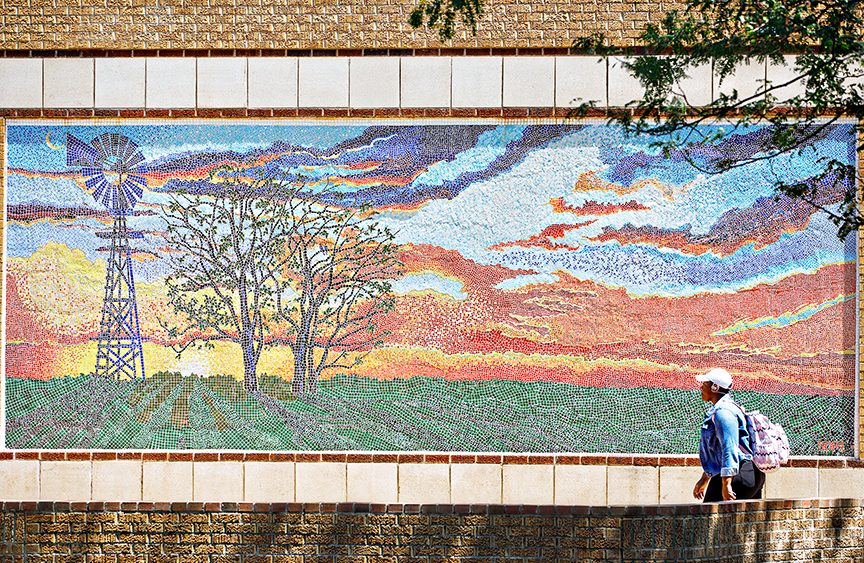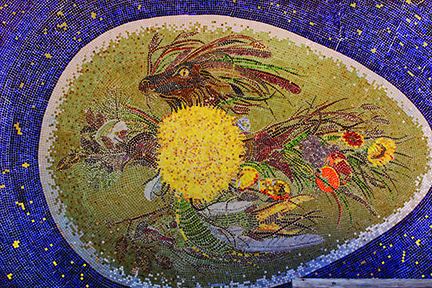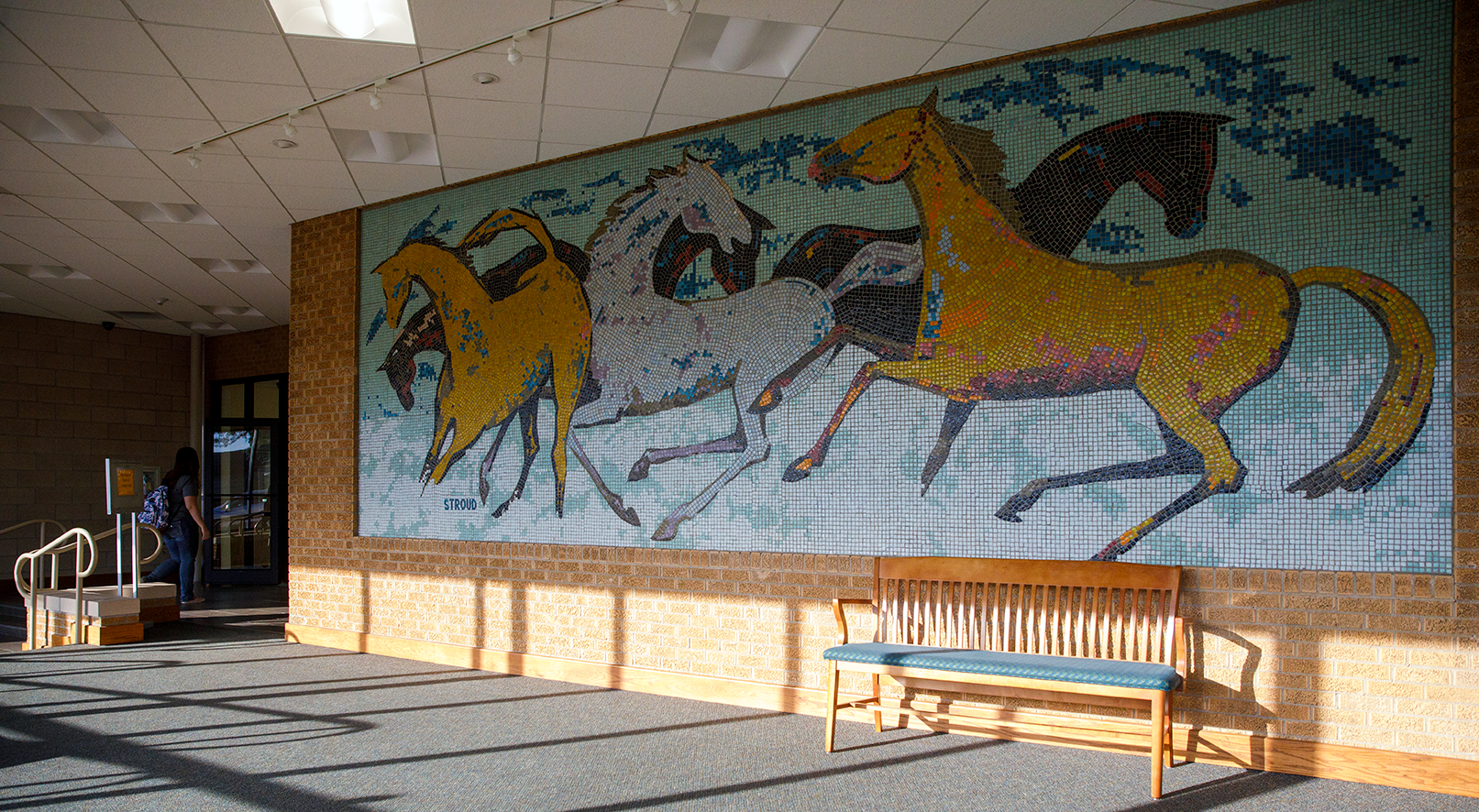
Speckled around the quiet streets of Levelland are various works of art that collectively come together to paint a visual history of Hockley County and the people who worked to make it what it is today.
Levelland is known as the "City of Mosaics." A mosaic is an ancient form of art that is comprised of small fragments of glass, stone, or a number of other materials that come together to form a large mural.
Each mural holds its own importance for the city that surrounds it. There are about a dozen pieces scattered throughout Levelland, and the South Plains College campus is home to five of these finely pieced installations. Ever since Don Stroud, then an art professor at South Plains College, installed the first mosaic in Levelland, "Wild Mustangs," in 1968, the city has steadily continued to add to their collection of public montages.
Two very meticulous local artists have worked diligently to ensure that the mosaics are in pristine condition. John Hope and his wife, Bette, not only make sure the pieces are well taken care of; they also have installed their own work for the city of Levelland.
The Hopes see the value in preserving the city’s installations. They know how to make and take care of mosaics, which, as it turns out, is quite tedious.
The Hopes have been involved in the city’s art since John Hope attended South Plains College.
The couple installed two smaller murals at the Hockley County Courthouse. The courthouse’s sign that sits on Avenue H holds a two-part piece called "Hockley County: Past and Present." These two pieces are highly intricate, even though they are smaller in size compared to some of the bigger pieces around the city.
"They still took over 2000 man hours to construct and install," according to John Hope.
The painstakingly precise placement of such small pieces of glass is truly mesmerizing. Each piece is carefully selected to ensure the right color matches its surrounding shards.
"A half-inch by half-inch square around the bison’s eye alone contains 35 individual pieces of glass," says Bette Hope.
Seeing the amount of detail put into these two small displays is captivating. An eagle-eyed passerby may notice a number of subtle nods to Levelland’s past, with each hint representing something important to the region’s past and future.
In addition to the two pieces the Hopes were commissioned to install, there are a number of other installations, all of which they watch with a close eye.
"Throughout all the years, none of the pieces have been vandalized," said Bette Hope. "They might mark on the wall next to a piece, but never on the actual mosaic."
Bette Hope says that she feels a special connection between the collection of art and the city of Levelland itself, as it is something the town can be proud of.
Near the intersection of MLK Jr. Street and Jackson Avenue is the "Chain of Life" mosaic. The 60-year-old piece was constructed to show the unity between all the races. The piece sadly sits on a "cinderblock wall that is beginning to deteriorate," according to Bette Hope. Since the 1960s, the piece has been a symbol of togetherness and love.
One of the pieces that many students have seen while traversing between classes is located on the west end of the Administrative Building on the Levelland campus and is called "New Morning." The montage is a depiction of a field with a windmill and a grouping of trees. While art is a subjective medium and the viewer is completely in control of what he or she takes away from it, John Hope describes "New Morning" as "trees representing professors and students, the windmill representing South Plains College itself, and the open field representing the future."
The mosaic "New Beginning-New Life" is located on the northern wall of the Science
Building. This piece is visually striking as well as one of the bigger mosaics in
Levelland. Originally, the piece was a painting by Ford Ruthling and was later converted
to a mosaic by Burl Cole. The piece displays a wide variety of colors and patterns that collectively form a story. The egg on the mural
represents the start of life in its simplest form. Inside the egg are multiple forms
of life, from basic plants to what appears to be a velociraptor. Outside the egg is
a somber dark blue background speckled with golden tiles to "represent the firmament,"
also known as "the heavens" or the sky.
variety of colors and patterns that collectively form a story. The egg on the mural
represents the start of life in its simplest form. Inside the egg are multiple forms
of life, from basic plants to what appears to be a velociraptor. Outside the egg is
a somber dark blue background speckled with golden tiles to "represent the firmament,"
also known as "the heavens" or the sky.
Levelland houses a total of 12 mosaics, and for this reason it is known as "The City of Mosaics." Other mosaics are:
"Hockley County Schools & Your Children’s Children," a second pair of large mosaics, is located at the corner of Avenue H and Austin Street. It is a sincere tribute to the educators and teachings of Hockley County’s forefathers; "Land of Soil, Oil, & Education," sits at 1101 Avenue H, and as the name suggests, honors the fruits of the surrounding lands that helped Levelland grow into the town it is today; "Through the Ages," located near 1101 Avenue H, while not a true mosaic, is a stoneware clay collage that takes a different approach to telling a history of Levelland.
Also, "Tree of Life" stands at the Levelland Clinic and expresses the importance of all the professionals in the medical field that provide their services to the public; "Arms of Care," situated at the Levelland Hospital on College Avenue, displays the connection between doctors, nurses, and the families they look after.
"Wild Mustangs," inside the Fine Arts Building at South Plains College, is the forefather of all of Levelland’s mosaics. The mural is a callback to the once wild and untamed mustangs that drew settlers from miles around to call this area their home.

Mosaics can be traced back to the dawn of humanity. They first appeared in Mesopotamia and have been improved upon ever since. The techniques are constantly being fine-tuned to ensure that these works of art will continue to captivate our minds. With proper care and public support, these magnificent collections will stand the test of time and be around long past the artists who assembled them.

